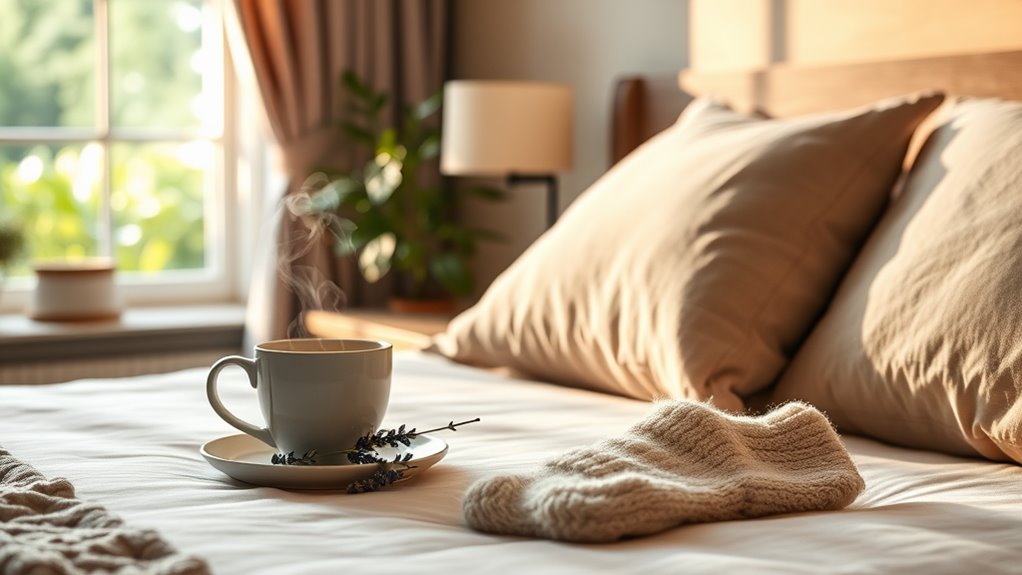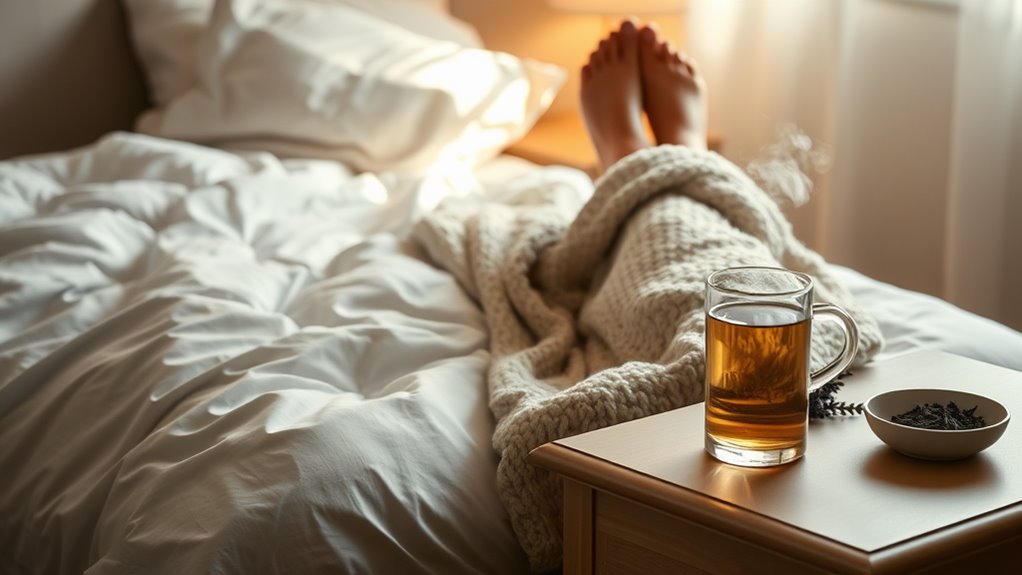Say Goodbye to Restless Legs With These Bedtime Tips
If you’ve ever tossed and turned at night, feeling an uncontrollable urge to move your legs, you know how frustrating restless legs syndrome can be. Fortunately, there are effective bedtime tips that can help ease those uncomfortable sensations. By making simple adjustments to your routine, you can improve your sleep quality and overall well-being. Curious about which specific strategies can make a difference? Let’s explore the best practices to say goodbye to restless legs.
Key Takeaways
- Establish a consistent bedtime to regulate your sleep schedule and promote better rest.
- Engage in a warm bath for 15 minutes before sleep to relax your muscles.
- Practice gentle stretches to improve circulation and reduce discomfort in your legs.
- Avoid caffeine, nicotine, and alcohol in the evening to minimize triggers for restless legs.
- Consider incorporating leg massage techniques to alleviate sensations and promote relaxation.
Understand the Causes of Restless Legs Syndrome
Restless Legs Syndrome (RLS) often stems from genetic factors, iron deficiency, or nerve damage.
It can also be linked to certain medications, chronic diseases, or lifestyle choices.
When you feel that twitching sensation, your brain might be signaling an imbalance in dopamine or other neurotransmitters.
To alleviate these symptoms, explore restless leg remedies like stretching, warm baths, or leg massages.
Some people find relief by avoiding caffeine and alcohol, while others benefit from iron supplementation.
Understanding these causes can help you manage your restless legs effectively. Additionally, lifestyle choices such as physical activity levels can significantly influence RLS symptoms.
Establish a Relaxing Bedtime Routine
Creating a relaxing bedtime routine can greatly reduce the discomfort of restless legs. Start by setting a consistent bedtime, allowing your body to wind down. Engage in calming activities, like reading or listening to soft music. Consider reducing screen time, as blue light can interfere with sleep. Additionally, incorporating relaxation techniques such as deep breathing or meditation can further enhance your bedtime routine.
| Activity | Duration | Benefits |
|---|---|---|
| Reading a book | 20 mins | Enhances relaxation |
| Meditation | 10 mins | Reduces stress and anxiety |
| Warm bath | 15 mins | Soothes muscles and mind |
| Journaling | 10 mins | Clears thoughts for better sleep |
Stick to this routine, and you’ll likely find relief.
Incorporate Stretching and Light Exercise
Incorporating stretching and light exercise into your routine can greatly ease restless legs. Simple stretches can improve circulation and reduce discomfort, while light activities like walking or yoga promote relaxation. Additionally, regular stretching and leg movement can significantly reduce RLS symptoms.
Benefits of Stretching
Although restless legs can disrupt your sleep, incorporating stretching and light exercise into your bedtime routine can greatly alleviate discomfort.
Stretching helps improve blood circulation, easing tension in your muscles.
By lengthening your muscles, you reduce tightness, which can trigger those restless sensations.
Additionally, stretching promotes relaxation, signaling your body that it’s time to unwind.
You’ll also notice better flexibility over time, which can enhance overall mobility.
Engaging in light exercises, like walking or gentle yoga, can further boost your mood and foster a sense of calm, making it easier to drift off to sleep without the nagging distraction of restless legs.
Ideal Light Exercises
Light exercises can play a significant role in easing the discomfort of restless legs and improving your sleep quality.
Incorporate gentle stretches like calf raises and hamstring stretches to release tension. Try ankle circles and toe taps to enhance circulation. A short, calming yoga routine can also help relax your muscles before bed.
Focus on deep breathing while you stretch, which can further reduce stress.
Aim for about 10-15 minutes of these light exercises nightly. You’ll not only soothe your legs but also prepare your body for a restful night, making it easier to drift off into sleep.
Optimize Your Sleep Environment
To get a better night’s sleep, you need to optimize your sleep environment.
Start by controlling the room temperature to find your ideal comfort level, and limit noise distractions that could interrupt your rest.
A peaceful setting can make a significant difference in managing restless legs and promoting relaxation. Additionally, creating a sleep-friendly environment enhances your overall sleep quality and contributes to better rest.
Control Room Temperature
How can controlling your room temperature enhance your sleep quality?
Keeping your bedroom cool can greatly improve your rest, especially if you struggle with restless legs.
Aim for a temperature between 60 to 67 degrees Fahrenheit.
This cooler environment helps lower your body’s core temperature, signaling it’s time to sleep.
When your room is too warm, it can lead to discomfort and restlessness, making it harder to drift off.
Consider using fans, air conditioning, or breathable bedding materials to maintain that ideal temperature.
A comfortable room not only promotes deeper sleep but also helps reduce those annoying restless leg sensations.
Limit Noise Distractions
While a cool room is essential for sleep, limiting noise distractions is equally important for a restful night, especially if you experience restless legs. Noise can disrupt your sleep cycle, making it harder to relax. Here are some effective strategies:
| Strategy | Benefits | Implementation |
|---|---|---|
| Use White Noise | Masks disruptive sounds | White noise machines or apps |
| Soundproofing | Reduces external noise | Weather stripping windows |
| Earplugs | Blocks intrusive sounds | Comfortable foam earplugs |
Explore Dietary Changes and Supplements
Have you considered how your diet might be affecting your restless legs?
Certain nutrients play a vital role in reducing symptoms.
Make sure you’re getting enough iron, magnesium, and folate, as deficiencies in these can contribute to discomfort.
Incorporating foods like leafy greens, nuts, and lean meats can help.
Omega-3 fatty acids, found in fish and flaxseeds, may also alleviate symptoms.
Additionally, consider taking supplements if you struggle to meet your nutritional needs through diet alone.
Just remember to consult with a healthcare professional before starting any new regimen.
Making dietary changes could be the key to a more restful night, especially since iron deficiency is a known trigger for RLS symptoms.
Limit Stimulants Before Bedtime
To enjoy a restful night, it’s essential to limit stimulants in the hours leading up to bedtime.
Caffeine, found in coffee, tea, chocolate, and some sodas, can keep you alert and interfere with sleep. Try to avoid these beverages at least six hours before you plan to sleep.
Nicotine, whether from cigarettes or vaping, can also disrupt your sleep cycle and exacerbate restless legs.
Additionally, be cautious with alcohol; while it may initially make you feel drowsy, it can lead to fragmented sleep.
Prioritizing a calming evening routine will help you wind down and prepare your body for rest. Incorporating relaxation techniques into your nightly routine can further enhance your ability to fall asleep peacefully.
Consider Professional Guidance and Treatment Options
If limiting stimulants doesn’t alleviate your restless legs, seeking professional guidance can be an essential next step.
A healthcare provider can help identify underlying conditions contributing to your symptoms.
They might recommend lifestyle changes, medications, or therapies tailored to your needs.
Consider a sleep specialist if your restless legs disrupt your sleep.
You could also explore options like cognitive behavioral therapy or support groups for additional strategies.
Remember, you don’t have to face this alone—professional support can make a significant difference in managing your restless legs and improving your overall quality of life.
Additionally, understanding the sleep-anxiety connection may offer insights into your condition and potential coping strategies.
Don’t hesitate to reach out for help!



